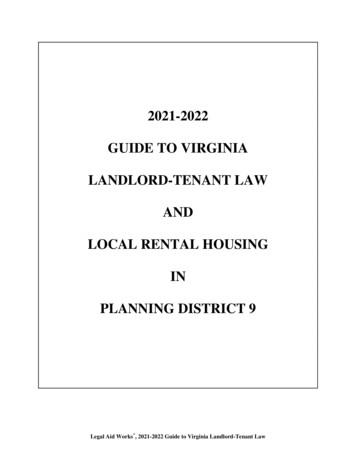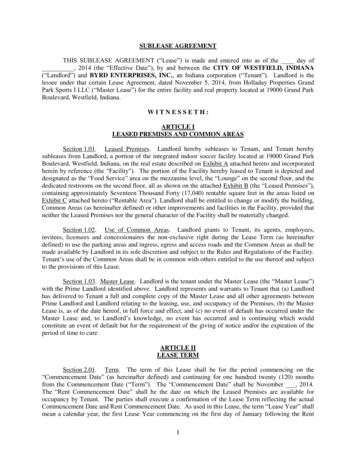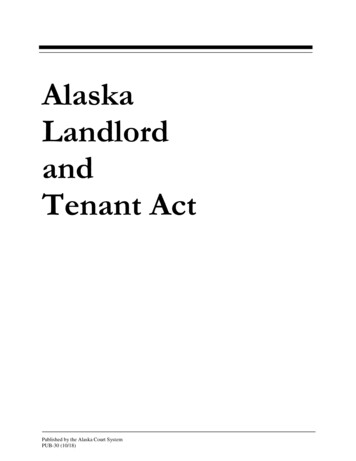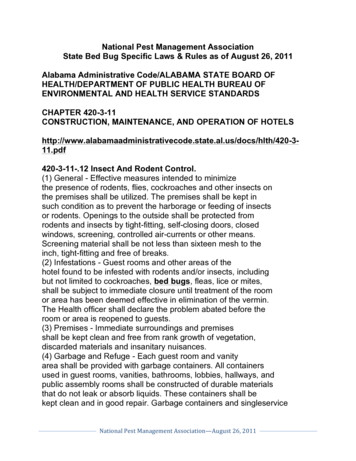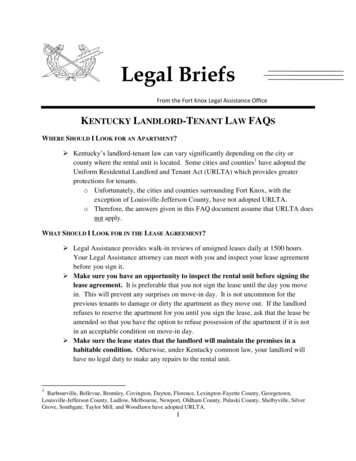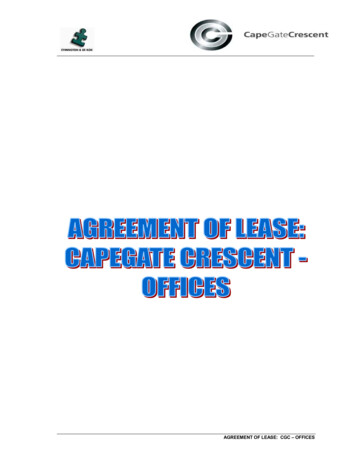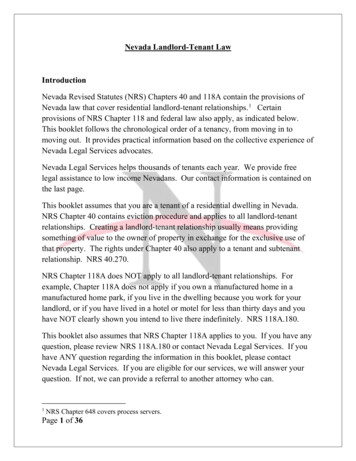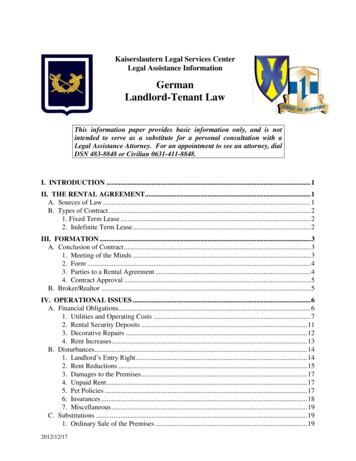
Transcription
Landlord & TenantHelpsheetLegalhelpers is strongly committed to providing quality legal assistance to landlords andtenants alike. Therefore, we have produced a range of documents obtainable to both parties,for the creation, alteration and subsequent termination of some of the most common tenancysituations.Why use Tenancy Agreements & Notices?When premises are let, it is always best to do so with a legally valid and clearly writtenagreement between the parties. Furthermore, it is a legal requirement for the landlord toprovide a written statement of the main terms of a tenancy agreement if requested by thetenant.For the landlord, a tenancy agreement allows them to secure certain legal undertakings fromthe tenants. Commonly, that they will not damage the property during the tenancy and willleave the premises promptly and in good order and repair at the end of the tenancy. For thetenant, it allows piece of mind that their occupation of the premises will be peaceful andwithout interruption, so long as they act within their agreement. Additionally, a good tenancyagreement will make clear all the obligations of both parties, so that should something gowrong during the tenancy, both parties know their respective responsibilities and duties,thereby resolving potential disputes before they occur.Notices are likewise an extremely important, but an often neglected area of tenancy law.Unfortunately, all too often, disputes will end in the courts because there was no notice served,or the notice served was invalid. Different tenancy agreements require different types ofnotice. In the case of an Assured Tenancy, a Section 8 Notice is always required, and thegrounds within it must be formally stated. With regard to Assured Shorthold Tenancies, aSection 8 and / a Section 21 Notice may be used to end the agreement. Finally, with regard toHouse & Flat Share Agreements, although a Notice to Quit may not be required in somecircumstances, it is always best practice to serve one.The Forms:We have endeavoured to make all Legalhelpers forms user friendly by removing as much legaljargon as possible.Nevertheless, there are still some terms within the forms, with which you may be unfamiliar, orwould like some clarification. Therefore, we have produced this help sheet to provide you withsome assistance. However, should you still be experiencing difficulties or feel uncertain as toany area of the forms, please do not hesitate to contact us.Below is a brief description of the various tenancy agreements that Legalhelpers provides, sothat you will be able to decide which type of tenancy agreement is the most appropriate foryour own particular situation. After this, there is a list of some common words and expressionsused within landlord & tenant law and a brief explanation of each.Page 1 Legalhelpers Limited
The Different Types of Tenancy Agreements:Assured Tenancy AgreementsAssured Tenancy Agreements and Assured Shorthold Tenancy Agreements are in themselvesvery similar documents. As a result of the similarity of their content as well as their names theycan often cause unnecessary confusion to many people. With regard to the agreement itself,there are only a couple of significant differences between the two, primarily to do with thelength of the tenancy and the protection granted to the tenant.An Assured Shorthold Tenancy Agreement, is usually used with the intention of granting thetenant a tenancy for a shorter period!If you wish to create an Assured Tenancy Agreement, this will have to be clearly stated at thetop of the tenancy agreement. If such a tenancy is created, the tenant will have more securityof tenure, in other words the procedure and amount of time required to end the tenancyagreement is much more complicated and lengthy than for an Assured Shorthold Tenancy.Ordinarily, Assured Tenancies are only created where it is the intention of both parties that thetenant should have possession of the premises for a longer time. To take repossession of anAssured Tenancy, the landlord will have to state very specific grounds, contained within theHousing Act 1988. Therefore, such an agreement should only be created when it is intended tocreate a long-term tenancy agreement, granting the tenant extensive possessionary rights.Assured Shorthold Tenancy AgreementAs mentioned above, an Assured Shorthold Tenancy Agreement, is merely a type of an AssuredTenancy Agreement and many of the provisions operate in exactly the same manner.Today, the Assured Shorthold Tenancy Agreement is the most commonly used type of tenancyagreement, and the one usually implied if the parties do not state what type of tenancyagreement they wish to create. Importantly, an Assured Shorthold Tenancy Agreement canallow either the landlord or tenant to end the tenancy after an initial six month period, bysimply serving upon notice upon the other. For the tenant this is usually one month and for thelandlord two months, please see our Section 21 Notice for more information.In relation to Assured Shorthold Tenancy Agreements, the relatively new Tenancy Deposit rulesapply and you may wish to read our Tenancy Deposit help sheet.House and Flat Share (Lodger) AgreementsBoth resident landlords and non-resident landlords can use these agreements. The mainpurpose is to create a tenancy agreement, which will not have the force of an Assured Tenancyor even an Assured Shorthold Tenancy Agreement. Thereby allowing both the tenant and thelandlord the opportunity of ending such an agreement quickly should they wish, these areregarded in law as ‘licence agreements’.With regard to a non-resident landlord in a house or flat share agreement, the tenant must begiven at least four weeks notice after the date when a notice to quit is given to them. Withregard to resident owners, although there is no prescribed period for giving notice in a house orPage 2 Legalhelpers Limited
flat share agreement, it is advisable to provide four weeks. Furthermore, in both instances ifthere is a written condition in the tenancy agreement that is longer than this, this should beused.Non-resident landlords can create House and Flat Share Agreements, which will act as licenceagreements, rather then tenancy agreements. However, this is a complicated area and thereare several cases on it. If in doubt, the landlord should create an Assured Shorthold TenancyAgreement.Nevertheless, some landlords like to create licences and therefore there is a little more detailcontained here. The most important case for the landlord which supports the licence argumentis A. G. Securities v Vaughan, which is still good law and the key case, despite its age! This caseinvolved a landlord letting rooms in the property to four people on licences. The House of Lords(the highest Court at the time) decided it was a licence rather than a tenancy. The key principlewas that the landlord had not let the property, nor indeed any part of it, to the occupiers withexclusive possession. Specifically, no particular rooms had been prescribed for any of theparticular occupiers. Should landlords seek to create this type of agreement, they are stronglyrecommended to read the case in full. We can forward a copy to you should you wish.Importantly, no individual rooms (bedrooms) were granted to any of the occupiers. Rather theyall came and went at different times, on different rents, and simply took informally whicheverbedroom was available to them. Had the landlord specified a room, there was someuncertainty as to whether that would have granted a tenancy. However, that doubt is nowgone as per the case of Uratemp Ventures Ltd v Collins, which is an example at the otherextreme, where a hotel room was decided to be capable of being a tenancy.Thus in simple terms:i) A single room in a property can be a tenancy and let as an Assured Shorthold TenancyAgreement.However,ii) A landlord could let several people have the use of a property, on individual licences, so longas they do not have exclusive possession or the property, or any part of it. i.e. they are notgiven a specific room for themselves. Rather, they would simply be allowed to have use of whatwas available. As mentioned, this is a tricky area and landlords should only attempt to set upthese types of agreements with care.High Rent / Common Law TenanciesNowadays most landlords create Assured or Assured Shorthold Tenancy Agreements. However,when the rent is above 100,000 per annum, which is annualised, meaning 8,333.33 permonth for a shorter periods the letting cannot be an Assured or an Assured Shorthold. We havecreated a tenancy agreement for High Rent situations, frequently called a Common LawTenancy.Page 3 Legalhelpers Limited
Our ‘High Rent / Common Law Tenancy Agreements’ are designed for all situations where therent exceeds 100,000 per annum. Importantly, the Tenancy Deposit Schemes do not apply,nor many of the various statutory notices to quit / regainBuy to LetOur Buy to Let Agreement is a variation of the Assured Shorthold Tenancy Agreement, whichcontains certain notices frequently requested by Banks and Building Societies for buy-to-letmortgage purposes. In many respects the information provided for the Assured Shorthold isexactly the same.Student LettingThere is a difference in student letting agreements made between private landlords (generalpublic) and those granted by Local Authorities and Educational Institutions. Our Student LettingAgreement is for use by private landlords.Essentially, the student letting agreement is a variation of the Assured Shorthold TenancyAgreement, allowing the landlord to regain possession fairly easily if required. However, it istailored to the typical student letting scenario, taking into account multiple persons in oneproperty and possible variation of rent according to holidays and different lengths of letting.Holiday LettingsA Holiday Letting Agreement is simply an agreement between the landlord and theholidaymaker for letting premises, with the intention of them being used for holidayaccommodation. As such, the Housing Acts make clear that this type of tenancy can not be anAssured Tenancy, which would give the holidaymaker(s) a greater right to occupy the premises.Importantly, the term of the letting agreement will ordinarily be quite short, often one or twoweeks, and usually less than three months.Page 4 Legalhelpers Limited
Meaning of Common Words and Expressions:Contents List or Inventory: simply a list of the contents of the rented premises. Often such listswill be attached to the tenancy agreement and signed by both the tenant and the landlord orthe landlord's agent, with both parties agreeing to what was and was not let as part of thepremises. It can include everything from the beds and wardrobes to the cutlery and crockery.Deposit: an amount of money that the tenant leaves with the landlord during the tenancy.Commonly this will be equal to one months rent. This amount will usually be paid back to thetenant at the end of the tenancy, so long as the premises and contents are left undamaged,other than fair wear and tear and the full rent has been paid. If the tenancy agreement is anAssured Shorthold, please ensure you have read the help sheet on Tenancy Deposits.Guarantor: a person who guarantees to the landlord that should the tenant be unable to paythe rent, or otherwise breach the tenancy agreement, they will pay any losses directly to thelandlord.Joint & Several: all persons who are made 'joint and several' are made responsible for eachother. This term is often used in tenancy agreements regarding rent and allows a landlord totake an assurance that each tenant will guarantee the rent of the other tenants. Should onetenant fail to pay their rent, the landlord is then able to recover this against the other tenants.Landlord: person or persons who lets premises for a rent to the tenants. Importantly, thelandlord must provide the tenants with a contact address within England and Wales. This mayeither be his or her own address, or someone who is acting as an agent for them.Landlord's Agent: this expression can have two common meanings. Firstly, it may be someoneemployed by the landlord for the renting of the premises being a person who deals with boththe landlord and tenant. Alternatively, it can also mean much more broadly anyone employedby the landlord to carry out any repairs or maintenance to the premises. Landlord’s agents canbe formally appointed such as letting agents or can simply be family and friends who act underthe landlord’s instructions.Notice to Quit: a formal written statement given by the landlord or the landlord's agentinforming the tenant that possession of the premises is required and the date upon which it isrequired. In order to be valid a notice to quit must satisfy certain conditions. If you requiremore information upon these documents, please contact Legalhelpers.Rent: an amount of money paid usually by the tenant to the landlord, in exchange for living inthe landlord's premises.Section 8 Notice: this is the type of notice that is required to be given to the tenant by thelandlord, if the landlord seeks to gain possession of premises let upon an Assured TenancyAgreement, or an Assured Shorthold Tenancy Agreement. The grounds contained within aSection 8 Notice are strictly regulated by statute, and you may wish to contact Legalhelpers forfurther assistance within this complicated area.Section 21 Notice: this type of Notice can only be used for Assured Shorthold TenancyAgreements and enables the landlord to bring the tenancy to an end without having to allegeany fault against the tenant. Ordinarily, two months notice is required, but there is a statutoryPage 5 Legalhelpers Limited
formula and it can sometimes be longer than this. Please see the our website where we dealwith Section 8 and Section 21 Notices for more information.Tenancy Agreement: formal document, which sets out the terms and conditions upon whichthe landlord is renting out the premises to the tenant. Ordinarily included will be conditions asto rent, length of the tenancy, and repairing obligations of the parties.Tenant: a person who rents premises from another person, the landlord or the landlord'sagent.Should you require any further help or assistance, please do not hesitate to contact us.Contact UsPlease visit our website at www.legalhelpers.co.uk for more information. Alternatively, youmay contact us:Email: info@legalhelpers.co.ukPhone: 0870 321 9865Fax: 0870 321 9866Post: Legalhelpers Limited, FREEPOST MID-23567, Stoke on Trent, ST1 5BRPage 6 Legalhelpers Limited
Below is a brief description of the various tenancy agreements that Legalhelpers provides, so that you will be able to decide which type of tenancy agreement is the most appropriate for your own particular situation. After this, there is a list of some common words and expressions used within landlord & tenant law and a brief explanation of each.

